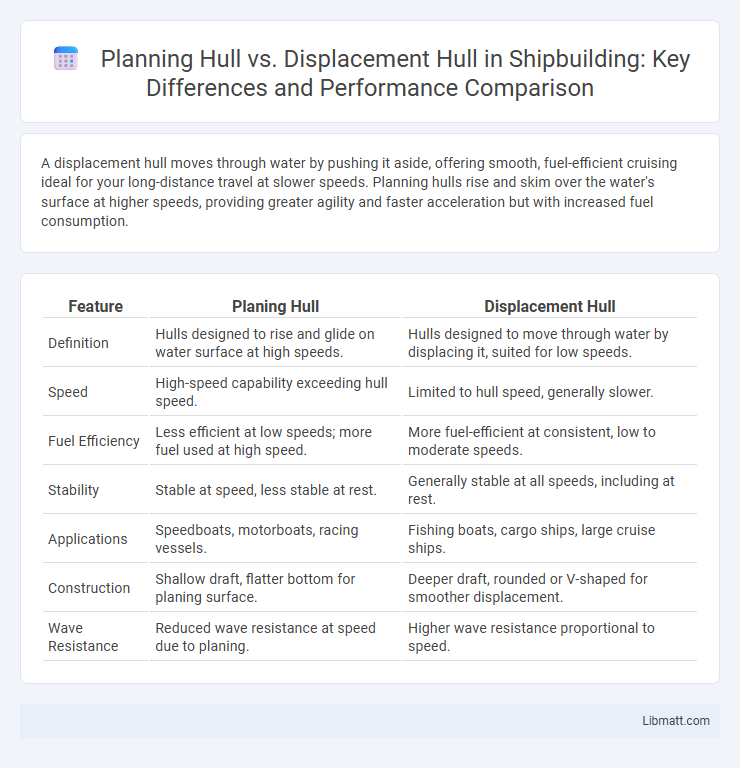A displacement hull moves through water by pushing it aside, offering smooth, fuel-efficient cruising ideal for your long-distance travel at slower speeds. Planning hulls rise and skim over the water's surface at higher speeds, providing greater agility and faster acceleration but with increased fuel consumption.
Table of Comparison
| Feature | Planing Hull | Displacement Hull |
|---|---|---|
| Definition | Hulls designed to rise and glide on water surface at high speeds. | Hulls designed to move through water by displacing it, suited for low speeds. |
| Speed | High-speed capability exceeding hull speed. | Limited to hull speed, generally slower. |
| Fuel Efficiency | Less efficient at low speeds; more fuel used at high speed. | More fuel-efficient at consistent, low to moderate speeds. |
| Stability | Stable at speed, less stable at rest. | Generally stable at all speeds, including at rest. |
| Applications | Speedboats, motorboats, racing vessels. | Fishing boats, cargo ships, large cruise ships. |
| Construction | Shallow draft, flatter bottom for planing surface. | Deeper draft, rounded or V-shaped for smoother displacement. |
| Wave Resistance | Reduced wave resistance at speed due to planing. | Higher wave resistance proportional to speed. |
Introduction to Hull Types
Planing hulls are designed to rise and glide on top of the water at higher speeds, reducing drag and increasing speed efficiency. Displacement hulls, on the other hand, move through the water by pushing it aside, offering better stability and fuel economy at lower speeds. Understanding these differences helps you choose the right hull type for your boating needs based on speed, stability, and fuel considerations.
What is a Planing Hull?
A planing hull is designed to rise and glide on top of the water at higher speeds, reducing drag and increasing velocity. Commonly found on speedboats and jet skis, this hull shape allows the vessel to lift off the water surface, enhancing maneuverability and fuel efficiency. Its flat or slightly curved bottom contrasts with displacement hulls by minimizing water resistance during fast travel.
What is a Displacement Hull?
A displacement hull is designed to move through the water by pushing it aside, rather than gliding on top, providing greater stability and fuel efficiency at lower speeds. Unlike planing hulls that lift and skim over the water surface, displacement hulls maintain constant contact with the water, producing minimal wake and offering superior load-carrying capacity. Commonly found in large ships and sailboats, displacement hulls excel in rough water conditions and long-distance cruising due to their steady, smooth motion.
Key Differences Between Planing and Displacement Hulls
Planing hulls rise and glide on top of the water at higher speeds, offering greater agility and speed, while displacement hulls push through the water, providing superior stability and fuel efficiency at lower speeds. Unlike displacement hulls that have a rounded shape for smooth water displacement, planing hulls feature flatter bottoms to facilitate lift and speed. Your choice between these hull types directly impacts performance, handling, and fuel consumption depending on your boating needs.
Performance Characteristics: Speed and Efficiency
Planing hulls excel in speed by rising above the water surface at higher velocities, reducing drag and enabling faster travel. Displacement hulls prioritize efficiency by pushing through the water with minimal resistance, favoring steady speeds and fuel economy. Optimal hull choice depends on desired balance between fast acceleration in planing hulls and smooth, energy-efficient cruising in displacement hulls.
Stability and Handling Compared
Planing hulls offer superior speed and agility, gliding atop the water surface for quick maneuvering but may sacrifice stability at low speeds or rough conditions. Displacement hulls provide enhanced stability and smooth handling by pushing through the water, making them ideal for steady cruising and heavy loads. The choice between planing and displacement hulls depends on the priority of speed versus stable handling in diverse water conditions.
Fuel Consumption and Operating Costs
Planing hulls typically consume more fuel at low speeds due to increased drag but become more efficient at higher speeds by gliding on the water surface, reducing operating costs during fast travel. Displacement hulls maintain consistent fuel consumption across speeds, offering better fuel efficiency at lower speeds and reducing overall operating costs for long-distance, steady voyages. Choosing between hull types depends on the balance of speed requirements and fuel economy to optimize operational expenses.
Best Applications for Planing Hulls
Planing hulls perform best in high-speed applications such as recreational powerboats, jet boats, and sport fishing vessels where quick acceleration and agility are prioritized. These hulls rise and glide on top of the water at speed, reducing drag and increasing fuel efficiency during fast travel. Their design excels in calm to moderately choppy waters but is less effective in rough seas compared to displacement hulls.
Ideal Uses for Displacement Hulls
Displacement hulls excel in applications requiring smooth, fuel-efficient operation at low to moderate speeds, such as long-distance cruising and heavy load carrying. They are ideal for sailboats, trawlers, and research vessels where stability and seaworthiness are critical. Their design allows for greater carrying capacity and enhanced performance in rough waters compared to planing hulls.
Choosing the Right Hull for Your Needs
Choosing the right hull depends on your boating activities and water conditions. Planing hulls offer high speed and maneuverability, ideal for water sports and shallow waters, while displacement hulls prioritize fuel efficiency and stability, perfect for long-distance cruising and rough seas. Understanding the trade-off between speed and stability ensures optimal performance and safety tailored to your specific needs.
Planing hull vs displacement hull Infographic

 libmatt.com
libmatt.com